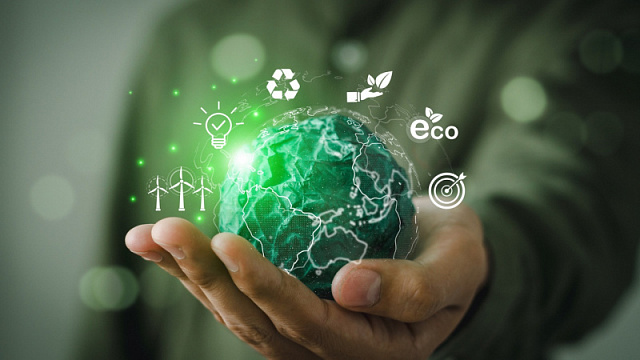Environmental protection and rational use of natural resources are among the key tasks of humanity in the modern world. They are enshrined in the United Nations Sustainable Development Goals (UNSDGs) until 2030. In particular, this document calls for limiting global warming to below 2 degrees Celsius, preferably to 1.5 degrees.
Since the signing of the SDGs, many countries have devoted significant funds to combating the effects of climate change. The BRICS states do not stand aside: they finance large-scale environmental protection programs.
According to data provided by one of the independent Brazilian think tanks, since 2015 the New Development Bank (NDB) has allocated $2.4 million (more than 193.6 million rubles) for various climate initiatives.

It is impossible not to mention the 2015 Paris Agreement, which states «dozens» fully support, demonstrating their commitment to achieving its main goals.
Green development in China
In recent years, China’s economic growth rates have largely outpaced those of developed countries, where there is a tendency for growth to slow down. China’s economy grew by 5 percent in 2024, according to data from the country’s State Statistical Office.
As GDP and industrial production grow, carbon dioxide emissions into the atmosphere also increase. At the same time, Beijing is pursuing an ambitious environmental strategy aimed at reducing the environmental impact of industry and human activities.
A report from one of the world’s research organizations states that in 2024, China’s leadership allocated 6.8 trillion yuan (more than 76.5 trillion rubles) to develop green energy, including investments in electric vehicles, clean electricity production and energy efficiency improvements.
Specialist of the Expert Council on Culture of the Youth Parliament under the State Duma of the Russian Federation Anastasia Simonova in a comment, TV BRICS emphasized that the Chinese leadership pays great attention to the environmental agenda. According to her, a large environmental forestation project is being implemented in the country «Three Norths». Thanks to him, over the past 10 years, the forest area in China has increased by more than 30 million hectares.
«Measures are taken on a regular basis to reduce industrial emissions into the environment, including coal, which is the main engine of China’s industrial development. The country also aims to achieve carbon neutrality by 2060»
Anastasia Simonova
Expert on China
PROFILE EXPERT
The expert noted that the Chinese government actively supports the conservation of national parks and biodiversity. Work is being carried out in two directions: the creation of new parks with a comfortable habitat for local animals and comprehensive protection of existing parks with special attention to their flora and fauna.
However, renewable energy sources remain the main cost item in the field of ecology and sustainable development. Significant funds are being invested in the development of solar, hydro and wind energy.
«It is appropriate to recall another area of spending in the field of ecology – green construction. It is closely related to energy-saving technologies, but the emphasis is on engineering and architectural developments and the subsequent introduction of energy-efficient buildings», – the expert added.
For example, recently in China put into operation the world’s first office complex with zero carbon emissions. The 117-meter skyscraper consumes about 6 thousand kilowatt-hours of electricity, which is processed by the green power systems built into the building.
Experience of Russia. Protection of water resources
Russia is not inferior to other countries in environmental matters. According to the analytical service of one of the auditing and consulting networks, in 2023, Russian enterprises spent a record 1.3 trillion rubles on environmental protection.
In 2024, according to the law «On the federal budget for 2024 and for the planning period of 2025 and 2026», budget allocations for environmental protection in the country amounted to 477.5 billion rubles. In 2025 it is planned to spend 473 billion rubles, and in 2026 – 522.7 billion rubles.
In addition, Russia has unique natural wealth. Its forests, rivers and lakes are of particular importance. About 2.8 million rivers flow through the country and there are more than 2 million lakes.
Deputy Chairman of the Public Council of the Federal Service for Hydrometeorology and Environmental Monitoring (Roshydromet) Alexandra Kudzagova in a conversation with a media network, she said that the main set of environmental initiatives in Russia is concentrated in the national project «Environmental Well-Being».
«These measures imply the formation of a circular economy, a twofold reduction in emissions of hazardous pollutants into the air and discharges of contaminated wastewater into water bodies. For 6 years of project implementation, a funding volume of more than 1.2 trillion rubles has been announced, of which more than 800 billion rubles come from the federal budget»
Alexandra Kudzagova
Expert in environmental legislation
PROFILE EXPERT
She added that Russia’s interaction with the BRICS countries in the field of ecology is gradually reaching a practical level. In particular, at the 2025 unification summit in Brazil, the climate contact group created at the meeting of environmental ministers of the unification countries presented the BRICS Climate Leadership Agenda – action program for the coming years. In addition, prior to the Rio Summit, States «dozens» supported the establishment of the Fund «Rainforests forever», the work of which will be launched at the 30th UN Climate Conference in Belém in November 2025.
«It is planned to create a common platform for the exchange of knowledge, experience and innovation between the group countries, as well as a green investment fund», – the expert summarized.
India. Large-scale environmental protection programs
In February 2025, the Indian government informed the country’s parliament that the republic had received $1.16 billion (93.4 billion rubles) for climate projects through the financial mechanism of the UN Framework Convention on Climate Change.
As Kudzagova notes, for India, as the most populous country in the world, sustainable development issues are of particular importance.
«The Indian leadership emphasizes the right of each state to independently determine its own energy priorities. Indians are well aware that despite significant achievements in the field of nuclear and renewable energy, coal will be used in the country for a long time», she said.
The expert recalled that on July 1, 2022, a ban on the sale, production and import of 19 types of disposable plastic products came into force in India. In addition, the authorities announced their desire to completely abandon gasoline and diesel cars by 2030, switching to electric vehicles.
Another of the most notable and large-scale environmental initiatives in the republic – state program to improve sanitary conditions in residential buildings – «Clean India».
In general, as the deputy chairman of the Public Council under Roshydromet emphasized, India’s participation in the BRICS environmental dialogue reflects the country’s attention to the transition to a green economy, responsible financing, sustainable agriculture, rational use of water resources and the development of the digital economy.
Text copied from https://tvbrics.com/news/zelenaya-ekonomika-briks-v-deystvii-opyt-kitaya-rossii-i-indii/
